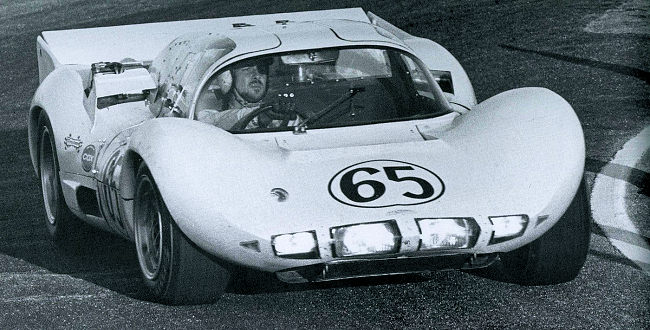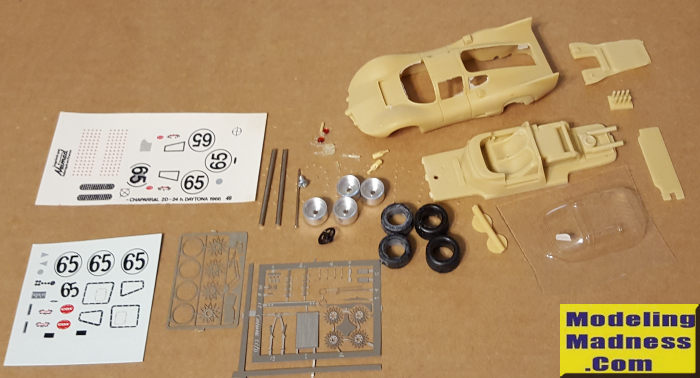
Provence Moulage 1/43 Chaparral 2D (Daytona 1966)
| KIT #: | K1522 |
| PRICE: | $42.00 'used' |
| DECALS: | One option |
| REVIEWER: | Scott Van Aken |
| NOTES: | Resin multimedia kit |

| HISTORY |
Chaparral Cars was a pioneering American automobile racing team and race car developer that engineered, built, and raced cars from 1963 through 1970. Founded in 1962 by American Formula One racers Hap Sharp and Jim Hall, it was named after the roadrunner, a fast-running ground cuckoo also known as a chaparral bird.
Hall and Sharp were both wealthy oilmen from Midland, Texas and this wealth allowed them to produce their famed Chaparral sports racers. Hall was one of the first to use physics to develop his racing cars and this allowed him to present many innovations in his cars. These were frequently copied by other teams.
A two-article series in Car and Driver magazine featured Hall's design theories. The article turns speculation about vehicle handling into applied physics. Hall's theories were the precursor to the elaborate data collection and management of current racing teams.
The 2D was the first closed cockpit variant of the 2-series, designed for endurance racing in 1966. It won at 1000 km Nürburgring in 1966 with Phil Hill and Joakim Bonnier driving. It also competed in the 1966 24 Hours of Le Mans, withdrawing after 111 laps. The Chaparral 2D was equipped with a 327 cubic inch displacement (5.3 liter) aluminum alloy Chevrolet engine producing 420 horsepower, and the car weighed only 924 kg. Like the Chaparral 2A/C it had a pedal operated spoiler in the back and an automatic transmission.
| THE KIT |
 This particular kit is the first Chaparral 2D coupe. It was developed
directly on the chassis of one of his early 2A/C cars, looking very much like
those cars. It raced in only one event, that being the 1966 Daytona 24 hours.
Later the 2D got a much more aerodynamic body, based on the information gleaned
from this car. An interesting note is the Hall built later versions of the
Chaparral 2 on the same chassis as the earlier cars, meaning that years later,
when asked if he could provide a photo of all the Chaparral 2 cars together, he
could not and some replicas had to be built.
This particular kit is the first Chaparral 2D coupe. It was developed
directly on the chassis of one of his early 2A/C cars, looking very much like
those cars. It raced in only one event, that being the 1966 Daytona 24 hours.
Later the 2D got a much more aerodynamic body, based on the information gleaned
from this car. An interesting note is the Hall built later versions of the
Chaparral 2 on the same chassis as the earlier cars, meaning that years later,
when asked if he could provide a photo of all the Chaparral 2 cars together, he
could not and some replicas had to be built.
Typical of Provence Moulage kits, the interior is built into the floor pan. This then fits into the once piece body when complete and is held in by a single screw. Also in resin are a couple of items that look like exhaust but are not really needed as those are cast in the floor pan. The wing, a blanking area in the back and the engine injector stacks are also in resin as are a couple of blanking plates for the front wheel inserts. Metal parts are limited to the aluminum wheels, the steel axles, mounting screw and a pin to be used for the shifter. Four rubber tires are provided as is a plastic steering wheel and a vacuformed piece for the windows.
Unlike some other kits, this one has two photo etch frets. Only the smaller one is called out in the instructions and includes a windscreen wiper, the add on oil cooler box that fits on the right side, inserts for the wheels, and a rear view mirror. The larger fret does include a seat harness and several other parts. It is listed as being for both the C and D versions of the Chaparral. A couple of stick on tail light lenses and the very small headlight lenses are provided as well.
Instructions are an exploded view of the parts and as mentioned, only the smaller photo etch fret is even shown. You get a five view of a completed model to help with painting and decal placement. This kit also comes with two decal sheets. I'm not sure why the upper sheet is provided as it seems all the markings are in the lower sheet, but it is there just in case, I guess.
| CONCLUSIONS |
For those of us who like the Chaparral, this fills an important slot in the history of these fascinating racing cars. I built the later, more refined 2D in 1/24 scale using the Fujimi kit and those wanting to duplicate this one in 1/24 can look for the Monogram kit (which is basically a slot car body with a plastic chassis). These kits are something I generally enjoy. Some can be a bit of a challenge, but the end result is a very nice car model and one that does not take up a lot of space when done. BTW the head photo shows Jo Bonnier driving this car in the 1966 Daytona race.
| REFERENCES |
May 2018
Copyright ModelingMadness.com. All rights reserved.
Thanks to www.dragonmodelsusa.com for the preview kit. You can find this kit at your favorite hobby shop or on-line retailer.
If you would like your product reviewed fairly and fairly quickly, please contact the editor or see other details in the Note to Contributors.
Back to the Main Page Back to the Previews Index Page Back to the Review Index Page